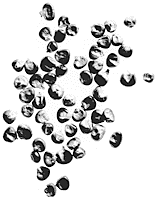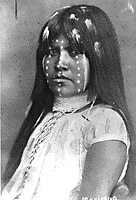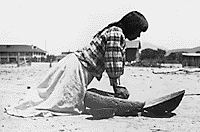
A traditional building constructed with mesquite, cottonwood, or willow posts and a roof of arrowwood or cattails.

The sand-colored stucco home where one Pima mother lives with her husband and three daughters in Bapchule is neat as a pin. Her household chores are good exercise, she says, to help control her diabetes. "I try to watch what I eat, avoid sweets, and take daily walks," she adds.

The woman's mother, who developed diabetes shortly after her daughter was born, died from kidney disease that developed from her long-term diabetes. Her father, a retired heavy equipment operator who had been very active in Reservation life, suffered an amputation—a complication of his diabetes—a year ago, after being hospitalized for several long months. "He got a sore on his foot and never got it treated," she explains. Four of her ten brothers and sisters also have the disease, which runs in families.
Although she has seen the worst diabetes can do, this mother is not giving up. What her father and other family members have gone through makes her want to take care of herself: "I could be in that same situation."
She is also motivated by wanting to see her three daughters, aged 12, 7, and 3, keep their health. All were big babies, and they have remained heavy for their ages. "All of my kids are chubby," she adds. That's common for babies born to mothers who have or are prone to develop diabetes, according to NIH researchers who are studying the disease in the Pima Indians. This mother is trying to teach her daughters to watch what they eat because being overweight can lead to diabetes.

Her third-grader, a pretty child with glossy black hair who likes to read when she isn't playing with her cat, already has diabetes. Her mother helps her monitor her blood sugar and is teaching her about choosing healthy foods, although she admits it's hard. When sweets are sometimes given out at school, her daughter gets a toy instead. "I tell her the cookies are gone, but you've still got the toy," her mother says.

Although researchers are still searching for the genes that cause diabetes in many Pima families, they say that cutting fat in the diet and exercising are the best ways yet known to prevent diabetes and modify its long-term effects.
"What I really want to do is change the way we eat here," the woman explains, referring to fried foods and the tacos the family loves. She knows that eating less sugar and fat is important for her family's health. "They say if you bake or broil, it's supposed to be better, and I've been trying to do that lately." Meanwhile, her mother's caring message seems to be having an effect on her daughter. Her favorite dessert is bananas.